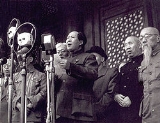
Wartime perception of the Chinese Communists
Encyclopedia
.jpg)
United States
The United States of America is a federal constitutional republic comprising fifty states and a federal district...
before and during World War II
World War II
World War II, or the Second World War , was a global conflict lasting from 1939 to 1945, involving most of the world's nations—including all of the great powers—eventually forming two opposing military alliances: the Allies and the Axis...
in both the public and the government. The debate revolved around the post-war character and intent of the Communist Party of China
Communist Party of China
The Communist Party of China , also known as the Chinese Communist Party , is the founding and ruling political party of the People's Republic of China...
, as an "agrarian reformer," a European-styled socialist nation that would preserve levels of capitalism
Capitalism
Capitalism is an economic system that became dominant in the Western world following the demise of feudalism. There is no consensus on the precise definition nor on how the term should be used as a historical category...
for an extended time until a peaceful transition to a fully realized communist society; or as a Marxist like communist party which would enact violent change in the same manner as the Bolsheviks in the Union of Soviet Socialist Republics.
Pre-War perception
For a more detailed history, see Communist Party of ChinaCommunist Party of China
The Communist Party of China , also known as the Chinese Communist Party , is the founding and ruling political party of the People's Republic of China...
Founded in 1921, the Communist Party was initially allied with the Kuomintang
Kuomintang
The Kuomintang of China , sometimes romanized as Guomindang via the Pinyin transcription system or GMD for short, and translated as the Chinese Nationalist Party is a founding and ruling political party of the Republic of China . Its guiding ideology is the Three Principles of the People, espoused...
until the second half of the 1920s, when it was purged from membership within the unified national government under Chiang Kai-shek
Chiang Kai-shek
Chiang Kai-shek was a political and military leader of 20th century China. He is known as Jiǎng Jièshí or Jiǎng Zhōngzhèng in Mandarin....
. In 1934, the party nearly annihilated, the rememnants under the guidance of future Chairman Mao Zedong
Mao Zedong
Mao Zedong, also transliterated as Mao Tse-tung , and commonly referred to as Chairman Mao , was a Chinese Communist revolutionary, guerrilla warfare strategist, Marxist political philosopher, and leader of the Chinese Revolution...
launched an ambitious march to escape destruction by the Kuomintang. The resulting action became known as The Long March. It was through the Long March that the United States, and much of the Western world, was first introduced to the communists in China via Red Star Over China
Red Star Over China
Red Star Over China, a book by Edgar Snow, is an account of the Communist Party of China written when they were a guerrilla army still obscure to Westerners. Along with Pearl Buck's The Good Earth, it was the most influential book on Western understanding and sympathy for China in the 1930s...
, a narrative of the march and introductory biography for several Communist leaders, by the American journalist, Edgar Snow
Edgar Snow
Edgar P. Snow was an American journalist known for his books and articles on Communism in China and the Chinese Communist revolution...
.
Snow's work cast the communists in a positive light and as those who wished to reform their country.
See also
- Communist Party of ChinaCommunist Party of ChinaThe Communist Party of China , also known as the Chinese Communist Party , is the founding and ruling political party of the People's Republic of China...
- People's Republic of ChinaPeople's Republic of ChinaChina , officially the People's Republic of China , is the most populous country in the world, with over 1.3 billion citizens. Located in East Asia, the country covers approximately 9.6 million square kilometres...
- History of the People's Republic of ChinaHistory of the People's Republic of ChinaThe history of the People's Republic of China details the history of mainland China since October 1, 1949, when, after a near complete victory by the Communist Party of China in the Chinese Civil War, Mao Zedong proclaimed the People's Republic of China from atop Tiananmen...
- Chinese Civil WarChinese Civil WarThe Chinese Civil War was a civil war fought between the Kuomintang , the governing party of the Republic of China, and the Communist Party of China , for the control of China which eventually led to China's division into two Chinas, Republic of China and People's Republic of...
- Dixie MissionDixie MissionThe United States Army Observation Group, commonly known as the Dixie Mission, was the first U.S. effort to establish official relations with the Communist Party of China and the People's Liberation Army, then headquartered in the mountainous city of Yan'an...
- China HandsChina HandsThe term China Hand originally referred to 19th-century merchants in the treaty ports of China, but evolved to reflect anyone with expert knowledge of the language, culture, and people of China...

